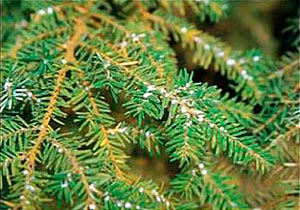 According to the Michigan Department of Agriculture and Rural Development, Hemlock Woolly Adelgid (HWA) has been eradicated from three counties across the state: two sites in Macomb County, two sites in Ottawa County, and multiple locations within Emmet County. HWA was first detected in Emmet County in 2006, then at the Macomb and Ottawa county sites in 2010.
According to the Michigan Department of Agriculture and Rural Development, Hemlock Woolly Adelgid (HWA) has been eradicated from three counties across the state: two sites in Macomb County, two sites in Ottawa County, and multiple locations within Emmet County. HWA was first detected in Emmet County in 2006, then at the Macomb and Ottawa county sites in 2010.
The infestations were believed to have originated from hemlock nursery stock originating from HWA-infested areas of the U.S. The infested trees at each site were removed and destroyed. Nearby trees were treated with pesticides and surveyed annually over the course of at least three years.
HWA is a small, aphid-like insect that uses its long, siphoning mouthparts to extract sap from hemlock trees. Native to eastern Asia, HWA was discovered in Virginia in 1951, and has since spread over an area from Georgia to Maine, decimating hemlock stands.
Over 100 million hemlock trees are present in Michigan forests, providing valuable habitat for a diversity of animals, including birds, deer, and fish. These trees are critical to the ecology and aesthetics of Michigan’s northern forests. Michigan law restricts the movement of hemlock into the state, and includes a complete ban on the movement of hemlock from infested areas.
Tree owners are asked to examine their hemlocks for the presence of white, cottony masses on the underside of branches where the needles attach. If you suspect HWA, contact MDARD immediately: email MDA-Info@michigan.gov or call 800-292-3939.
For more information on the HWA quarantine or other exotic pests, go to www.michigan.gov/exoticpests.

Susan Doll says
I have been looking for a possible reason that our huge hemlocks don’t seem to be infested with wooly Adelgid right now—-they were heavily infested for two years. I see no sign of them!
Am in Eastern Pa.
jhofley says
Hi Susan-
It’s hard to say. We suggest you take a sample from your tree to your local nursery or a certified arborist for evaluation.
-Jonathon